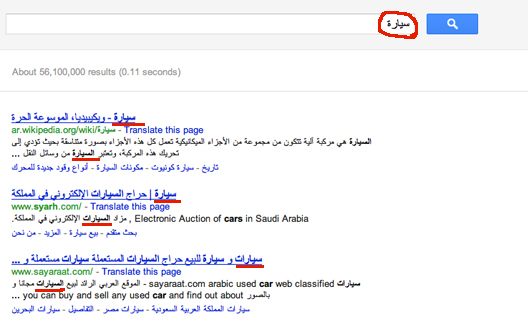Arabic SEO Part One: Content Optimization

 Building on my first post on Wamda, “SEO 101 for startups,” which gives a quick summary of search engine optimization, this post will address SEO for Arabic websites.
Building on my first post on Wamda, “SEO 101 for startups,” which gives a quick summary of search engine optimization, this post will address SEO for Arabic websites.
There are three building blocks for every SEO Campaign that can be summarized as follows:
- Content. eliminating duplicates, using internal linking, on-page SEO, and keyword research will help you enhance content.
- Accessibility: improving technical SEO factors for crawlability and indexation plays an important role on Arabic sites.
- Trust: link building will help you increase your perceived authority and trust.
In this post, I will focus on 1. Content, covering 2. Accessibility and 3. Trust in the next posts.
1. Content optimization
Before you start any SEO campaign, first you must research keywords and understand your target audience. For an English language site, this is straightforward. Because it is the most common language used online, there is a lot of data provided by Google Adwords Keywords and other intelligence tools that can help you narrow your niche and optimize for it.
Arabic Keywords
Optimizing Arabic content is different ballgame. The difference between spoken Arabic and written Arabic complicates the matter, as there are five major dialects, Egyptian, Maghrebi, Levantine, Gulf, and Mesopotamian Arabic.
If you are localizing an English site by taking it into Arabic, try to understand your userbase- what are their demographics and cultural factors? Which keywords do they use when surfing?
For instance, if you’re looking to optimize a website for users in Saudi Arabia who are looking for apartments or homes for sale.
As an Arabic speaker, using my knowledge of different dialects, I can assume that there at least 4 major broad keywords that users may type when searching for Real Estate:
- بيوت
- شقق
- منازل
- عقارات
But which one of these 4 keywords should I use as a “primary keyword”? In other words, which will send me the most traffic?
To assess this I can use Google Insights for Search and plug in these keywords, setting a filter for location: Saudi Arabia. Here I find that the most common keyword used is “شقق”, yet the keywords “بيوت “ and “منازل “ are also very important.
Next I can plug the keyword ” شقق” into the Google Adwords keywords tool. Under “Advanced,” I set these parameters: Location: Saudi Arabia, Language: Arabic, and Match Types: Broad AND Exact.
From this query, I can find out that not only is “شقق” the most common keyword used to search for real estate in Saudi Arabia, but the majority of searches are long tail, which means that searchers do not simply confine themselves to a few keywords, but rather many other keywords get a small amount of hits as well.
It’s useful to address these searchers as well by creating a long tail strategy. While this may take a little more planning, essentially a good long tail strategy comes down to creating more descriptive text and categorizing your keyword with modifiers, that help generate related words that may be used in search, like actions, conditions, types, and locations related to your main keywords. You can read more about long tail strategies on several sites including this one.
Optimizing HTML
The next step in optimizing the page is ensuring that these items then reflect those keywords that you have determined:
- Title tags (which should also include your company name)
- Meta description (include primary keywords, and action words, but avoid stuffing in too many keywords)
- Meta keywords (Google ignores these, but you might optimize them for Bing or Yahoo)
- Content: your content in general should contain these descriptive keywords.
- H1/H2 headers on your page: It’s also good if the headers on your page orient the searcher to the keywords they are looking for.
More general tips for Arabic SEO:
- For a database-driven website, convert your database to UTF8-General encoding to allow the database to read Arabic Letters.
- When writing title tags, you can use the SERP Preview tool to preview how your site will appear on the search engine results page (SERP) for different search engines. Or, if you are using Wordpress, you can install Wordpress SEO from Yoast, which by default includes a “SERP Preview” embedded in its Posts and Pages. These tools will help you visualize your page’s ranking.
In general, when it comes to optimizing your SEO in Arabic, it’s critical to understand the language and its dialects well. If you’re localizing a site, having a translation agency (or a native speaker onboard) that can produce local terms is crucial.
In the next post, I will discuss increasing accessibility on your site by enhancing its crawlability and indexing.
If you’re an Arabic webmaster, please comment below, I would love to hear your stories and experiences with Arabic SEO.


